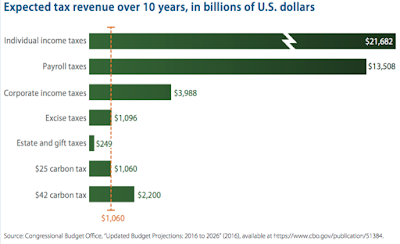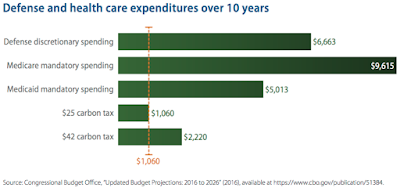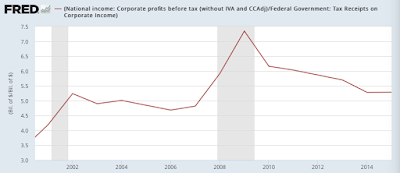This article was last updated on April 16, 2022
Canada: ![]() Oye! Times readers Get FREE $30 to spend on Amazon, Walmart…
Oye! Times readers Get FREE $30 to spend on Amazon, Walmart…
USA: ![]() Oye! Times readers Get FREE $30 to spend on Amazon, Walmart…
Oye! Times readers Get FREE $30 to spend on Amazon, Walmart…
A recent analysis by the Center for American Progress, a left-leaning public policy research organization, looks at the pricing of carbon and how a carbon tax will impact the U.S. economy and the revenue stream for the federal government. In general, opponents to the imposition of carbon taxes argue that such taxes will prove to be punitive to companies that are forced to pay for their carbon emissions and that it will ultimately have a devastating impact on the American economy. The analysis by the Center for American Progress looks at the revenue that would be generated by a carbon tax and puts it into the context of total federal government revenues, providing us with a means to measure the impact of carbon taxation on Corporate America.
As background, carbon pricing is a means to offset the costs to society such as health issues, impact on agriculture and ecosystems that occur as a result of carbon emissions. By implementing carbon taxes, the costs associated with carbon emissions are borne by the carbon emitter which will drive future reductions in emissions. Carbon pricing can occur in two ways:
1.) Emissions trading – this is also known as cap and trade, a system where there is a cap placed on emissions and emissions permits are allocated based on the cap. These permits can then be either sold or bought by participating nations, giving carbon emitters the option to pay the costs of carbon emitting or reduce emissions thereby reducing their associated costs.
2.) Carbon taxes – these taxes are either applied to the amount of carbon contained in various types of hydrocarbon-based fuels or in the volume of greenhouse gases that are emitted.
Currently, approximately 40 nations have implemented a price on carbon, representing about 25 percent of global greenhouse gas emissions. In 2014, 25 percent of Americans lived in jurisdictions where carbon pollution is priced, representing nearly 30 percent of the nation's economic activity. For example, the current tax on carbon in California is $13 per ton, the highest of any state in the United States. The Regional Greenhouse Gas Initiative (RGGI) is the first mandatory market-based program in the United States designed to reduce greenhouse gas emissions from the power generation sector. The RGGI is a co-operative effort among the states of Connecticut, Delaware, Maine, Maryland, Massachusetts, New Hampshire, New York, Rhode Island and Vermont. The RGGI implemented a cap of 91 million short tons in 2014 with a decline of 2.5 percent each year between 2015 and 2020. The RGGI distributes most carbon dioxide allowances through quarterly carbon dioxide allowance auctions; proceeds from the auctions are returned to the participating states and invested in energy efficiency programs, renewable energy programs and direct energy bill assistance. Here is a screen capture showing the results of the auction held on June 1, 2016:
It is interesting to note that the final price was $4.53 per ton and that there were 3.1 bids for every allowance auctioned. Since 2008, the RGGI has collected more than $2.4 billion in revenue.
Let's look at the current federal government revenue stream so that we can put the revenue generated from a carbon tax into context. Between 2017 and 2026, the federal government is projected to collect $42 trillion in tax revenue from the following sources:
1.) individual income taxes – $21.682 trillion
2.) payroll taxes – $13.508 trillion
3.) corporate income taxes – $3.988 trillion
4.) excise taxes – $1.096 trillion
According to projections by the Congressional Budget Office (CBO), a carbon tax with a base price of $25 per ton with a 2 percent annual price increase will raise $1.06 trillion over the same ten year period from 2016 and 2025. Here is a graphic showing how the $25 per ton and a $42 per ton carbon tax (as proposed in the Senate) would add to the federal tax revenue stream in comparison to the aforementioned taxes:
A $25 per ton tax would increase federal tax revenues by $1.06 trillion over the the year period, an increase in aggregate revenue of only 2.6 percent. A $42 per ton tax would increase federal tax revenues by $2.2 trillion resulting in an increase in aggregate revenues of 5 percent.
Here is a graphic showing how the revenues from the $25 per ton and $42 per ton carbon tax will do very little to offset spending on defense, Medicare and Medicaid over the ten year period:
Since much of the pushback against the imposition of a carbon tax is related to the higher costs that businesses will face which will result in a strongly negative impact on the American economy, here is a graph showing how federal revenues from corporate taxes have changed as a percentage of profits since 2000:
In 2015, corporate taxes as a percentage of profits were at their lowest level since 2008. This means that since the Great Recession, overall profit growth has outstripped the growth rate of Corporate America's tax bill, suggesting that Corporate America has the ability to pay for a reasonable carbon tax without impacting its overall business model.
The analysis by the Center for American Progress suggests that, while the imposition of a carbon tax will generate additional revenue for Washington, it will not enrich the federal coffers to any great extent. Additionally, the roughly $100 billion in annual costs to Corporate America as a whole is unlikely to severely impact its ability to continue to grow and create jobs for millions of Americans who are still out of work seven years after the end of the Great Recession.
Click HERE to read more of Glen Asher's columns
You can publish this article on your website as long as you provide a link back to this page.





Be the first to comment